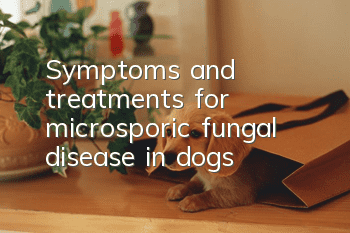Symptoms and treatments for microsporic fungal disease in dogs

(Original title: What should I do if my pet has canine microsporal fungal disease?)
Li Yuankui
Expert Encyclopedia
Expert profile: Li Yuankui, master of veterinary medicine at South China Agricultural University, attending physician at Ruipeng Pet Hospital, expert in dermatology and oncology at Ruipeng Pet Hospital, distinguished lecturer at VIC Dermatology China in France, distinguished lecturer at Fujian Longyan University, the first "Xiong" Won the second prize in the Internal Medicine Expert Group in the "Eagle Cup" Small Animal Physician Skills Competition. After more than ten years of practice, he has treated tens of thousands of cases and accumulated rich experience in the treatment of infectious diseases, common diseases, and skin diseases in dogs and cats.
Microsporum canis is a common clinical opportunistic pathogenic bacteria in pets, which can exist for a long time without causing disease. Pets can become infected when their skin barrier is damaged, excessive scratching or bathing, trauma, parasitic infection and low immunity.
Initially, when there is a small amount of infection, some inflammatory cell infiltration can be seen in the epidermis. As the infection worsens, it gradually invades the hair follicles, and the hyphae and conidia invade the cuticle (hair shaft) of the skin and its accessory organs, resulting in the formation of scaly scabs on the skin surface, hair loss, and increased secretions. This skin disease can occur in dogs and cats, accounting for about 30% of skin diseases in dogs and cats, and is most common in British shorthair cats and exotic shorthair cats.
When pets are infected with Microsporum canis, a few pets with strong immunity and good skin repair abilities can repair themselves, but most sick pets require treatment. Before the cause of the disease is found, do not use topical drugs without examination and diagnosis, otherwise it is easy to relapse or even worsen the condition. It is recommended to take it to a local pet hospital for corresponding skin disease examination and consult a pet doctor for reasonable symptomatic treatment.
Once a Microsporum canis infection is diagnosed, treatment should be thorough, and some even require continuous treatment for more than half a year. In small animal clinical medicine, in addition to oral or injected antifungal drugs, external medicinal baths are effective in treating Microsporum canis. At the same time, we should actively improve the pet's physical condition, rationally use unsaturated fatty acids, and thoroughly disinfect the environment to prevent recurrence.
Reported by: Guangmingtong reporter Chen Ziyan
Recommended Good Things
Aineng Pet Odor Eliminating Disinfectant can effectively remove body odor/feces odor and other odor molecules! Effective in treating skin diseases caused by fungi/bacteria! Can kill parvovirus/canine distemper virus/coronavirusetc!
It is edible grade for pets, does not contain fragrances, does not contain chemicals, can be sprayed directly, and is harmless to human pets!
consult:13028809308 (WeChat synchronization)
Scan the QR code on WeChat to enter the purchase
- Why does the dog keep shaking?
- Things to note when breeding Teddy
- What are the causes of bad mouth in dogs?
- Learn how to feed scientifically, and your Labrador will not be far from a racing dog
- How to treat diarrhea in a two-day-old dog
- Why do dogs keep biting their own tails?
- What dogs should not eat during pregnancy Precautions for dogs during pregnancy
- Most dogs over the age of three suffer from various dental diseases
- How to take care of your dog when he is sick
- American Urine off urea can effectively reduce canine leptospirosis virus??



